A Secret Ceremony, Preserved on Film
A film so rare that its like may never again be made is now stored in the moving-image archives of Australia’s national research and collecting institution of Aboriginal life.
n
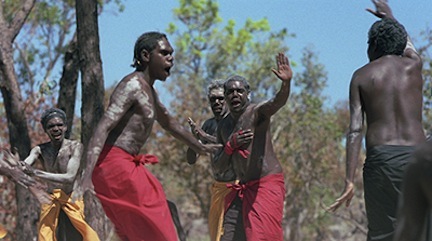
n
In the law and custom of many Aboriginal and Torres Strait Islander clans, names and images of the dead are not mentioned or displayed. That observance has been relaxed in recent decades, but only to the extent that cautions are issued if such names and images are about to be stated or displayed:
n

n
At the beginning of television or radio broadcasts relating to Aboriginal life and public affairs, or at exhibitions of art or historical photography, users encounter a caution that is are some variant of this one, from the audiovisual-collection website of AIATSIS, the Australian Institute of Aboriginal and Torres Strait Islander Studies: “Users of this catalogue should be aware that, in some Aboriginal and Torres Strait Islander Communities, seeing images of deceased persons in photographs, film, and books or hearing them in recordings etc. may cause sadness or distress and in some cases, offend against strongly held cultural prohibitions.”
But film footage that has just gone to AIATSIS would seem liable to run afoul of all those stipulations and alerts. It not only includes images and states the name of a deceased esteemed elder; it also contains footage of the funerary rites that were observed in the years that followed his death in 2005.
“It’s only proper because of the person involved,” says John Paul Janke, director of community affairs and public relations at the institute. “He realized that when he died a lot of culture and ceremony would die with him. He broke with tradition as a way of teaching his culture to a lot of people.”
For many years, ethnographers have filmed some Aboriginal rites and ceremonies, but funerary and other sacred rites have been taboo. In 2002, approaching death, Bill Neidjie of the Bunitj clan of the Northern Territory requested not only that he be named, but that his funerary rites be filmed. Neidjie knew when he passed on, much knowledge of his people and country would, too: language, songs, dance, ceremonies knowledge, stories.
So strong was his determination to give his country’s traditional ways some hope of persisting that he broke with tradition and requested his funeral be filmed and his image, voice, and stories shared into the future.

n
Neidjie, who was the last speaker of the Gagudju language from the northern reaches of Kakadu National Park, He was also among the few people who still knew well his country’s cultural and spiritual practices. He reasoned that the best hope for the practices would be to preserve at least some of them on film. “This culturally important ceremony is a story emanating from the oldest continuing organised societies in the world,” said AIATSIS Council Chairperson, Professor Mick Dodson.

Big Bill Neidjie, from the film “Story About Feeling.”
n
Neidjie was affectionately known as “The Gagudju Man” because, as a senior elder in the region and traditional owner of Bunitj country in northern Gagudju (the name from which Kakadu stems) he was instrumental in having Kakadu National Park established as a national trust in three stages between 1979 and 1991.
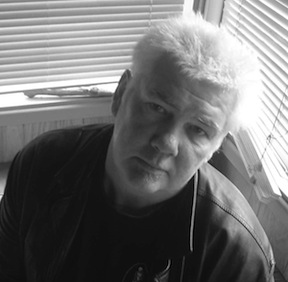
Kevin Lucas
At the time of his death, his countrymen prepared his body with gapan (sacred ochre), wrapped it in bark, and placed it on a platform where it remained for three years. Then, his clansmen performed an Old Man’s Bone ceremony, called Lorrkkon.
The filmmakers whom Kakadu elders approved to capture film of the events were Kevin Lucas and Djakapurra Munyarryun, along with MusicArtsDance film producer Aanya Whitehead. They collaborated with the Neidjie family on the rare undertaking. “Bill’s funeral ceremony extended over several years and the Bone Ceremony, which we captured, is how it was done in old times, is a ceremony for men of high-degree,” says Lucas. “The footage has World Heritage value because it holds what we call an intangible culture asset and the Neidjie family and the community entrust AIATSIS to provide a secure and tangible home for the original footage, which remains the property of the Neidjie family.”
In a Bone Ceremony in Bunitj country, the desiccated remains of a man of high degree are cleaned, enclosed in a log or wooden container, and placed for safe keeping in a secret cave in the Valley of Bones at Hawk Dreaming in Kakadu National Park to ensure that the elder’s spirit may join with his family to continue their care and lawful management of their lands.
So depleted are the remaining numbers of tribal elders of high degree in the Kakadu region that the ceremony is likely never to take place there again. “Bill Neidjie was one of the last traditional elders of that country,” says AIATSIS’s Janke. “He hit the nail on the head when he said the younger generation aren’t really interested in the traditional lifestyle Bill was bought up. But he hoped that, down the track, there’d be a reinvigoration of interest through films like this because younger indigenous Australians would come to identify with that older life, again.”
Already, he says, gains are being made, in that effort. “We’re trying to find how to bridge that gap between generations. You can do some of that using iPads or iPhones. The challenge for us is to figure out how do we put that out there.” Also hopeful, he adds, is that schools and even preschools increasingly are including Aboriginal perspectives in the teaching of Australian history and society, and that has been one element in a marked increase in white Australians’ knowledge of the country’s history, not always an edifying one.
n
Lucas and Munyarryun’s film of the ceremony contains a number of elements — not only the Lorrkkon ceremony, but also details of Big Bill Neidjie’s life and his recounting of traditional stories. Lucas and Munyarryun are making a separate large-format film, Story about Feeling, around the stories. A writer, Keith Taylor, is collaborating with them on a book of the same title.
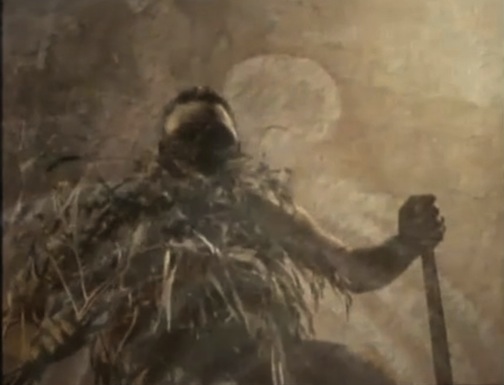
A scene from “Story About Feeling.” [To view film of the Lorrkkon ceremony for Bill Neidjie, click on the image. Australian Aboriginal and Torres Strait Island people are cautioned that the film contains images and sounds of the deceased.]
n
[Continued below]
n
n
n
n
n
n
n
n
n
n
n


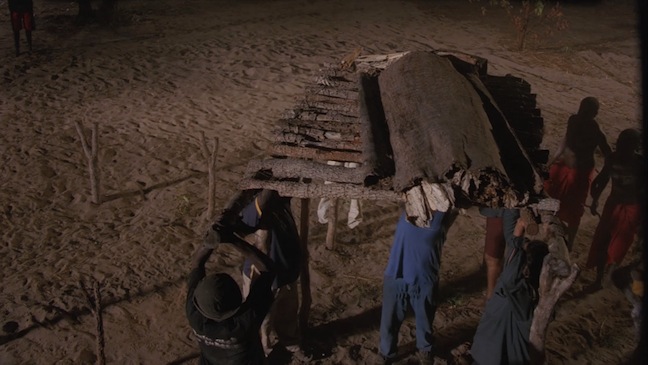
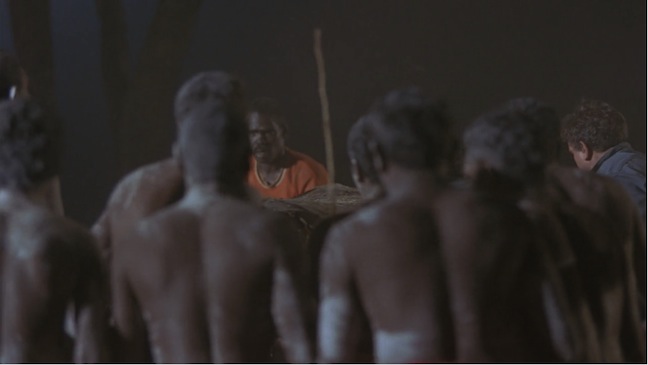
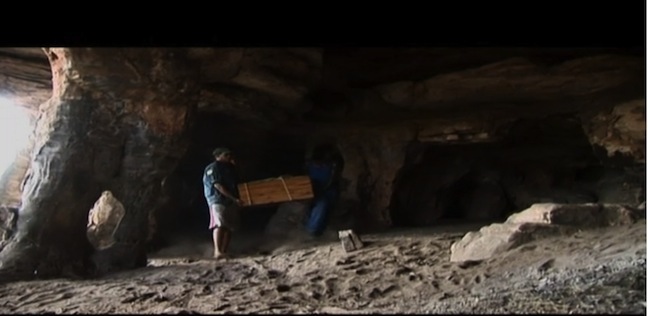
Archivists at AIATSIS received the film in Canberra on March 25 at a reenactment of portions of the Lorrkkon ceremony, in the first such performance in public or outside Bunitj Country. It took place in front of the buildings that served as Australia’s parliament house from 1927 to 1988.
On ceremonial grounds in front of the complex, an unofficial but now four-decade-old Aboriginal Tent Embassy stands, a reminder to parliamentarians and the Australian public of the long history of cruel or neglectful treatment of indigenous Australians.
Aboriginal men and women have continuously occupied the pointedly named structure since it was first set up as a rough-hewn shelter akin to those in which tribal Aboriginal Australians have lived for some 40,000 to 50,000 years. In its first decade, opponents within parliament and police repeatedly tried to remove the protest structure.
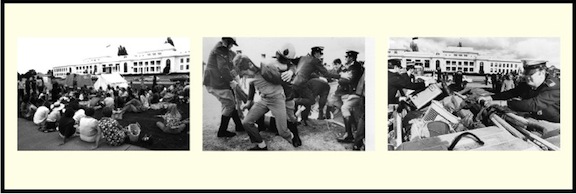
Scenes at the Aboriginal Tent Embassy in 1972, the year it was established. Photos: aboriginaltentembassy40th.com
Both the old Australian parliamentary buildings and the Aboriginal embassy are within close view of the country’s current Parliament House.
The Lorrkkon took place on specially prepared Bunggul (ceremonial) ground. Binninj ceremonial leader Ronald Lamilami and Yolngu ceremonial elder Djakapurra Munyarryun of the Wangurri Clan in Northeast Arnhem Land led proceedings, just as both had led the ceremony at the Hawk Dreaming bone ceremony in 2005.
Munyarryn says of the reenactment and presentation of film of the original ceremony: “We are doing this for that old man — it was his vision. That’s what he wanted; to teach about our ways and pass that onto Indigenous and non-indigenous. That’s what he gave us.”
Elders and 30 dancers from Northeast Arnhem Land (Yolngu) and Western Arnhem Land (Bininj) and the nearby islands of Goulburn and Croker helped fulfil cultural obligations to Bill Neidjie’s family and country. The events involved both Yirritja and Dhuwa moieties — of which everything in the Yolngu world view is made.

Family members presented Kevin Lucas’s film footage to the AIATSIS Council Chairperson, Professor Mick Dodson. Images: AIATSIS
Binninj ceremonial leaders passed the film to the deceased elder’s children and grandchildren to pass to AIATSIS officials. Following the ceremonial handover and acceptance speeches, the group returned to the centre of the Bunggul ground for a cleansing smoking ceremony. The dancers and songmen then returned to the stage to lead a song cycle that welcomed the setting sun.
The rare film document enters an extensive archive of 26,000 audio-visual artifacts that relate to Aboriginal life, history, and culture.
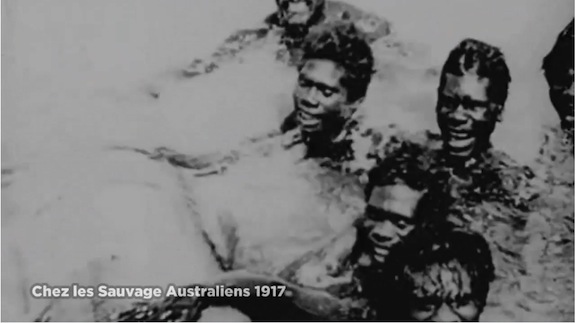
From a 1917 film, “Sauvage australiens.” AIATSIS
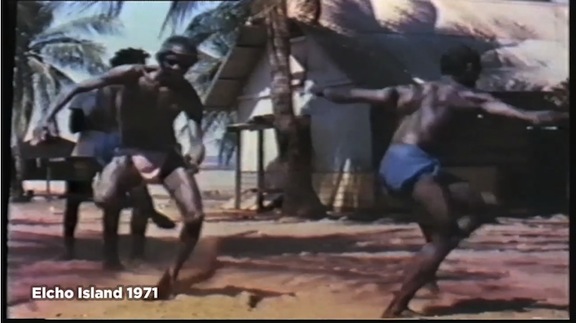 — Peter Monaghan
— Peter Monaghan
Previous Post: Cinema from the Sun
Next Post: Notes on archiving, collecting, and whatnot





